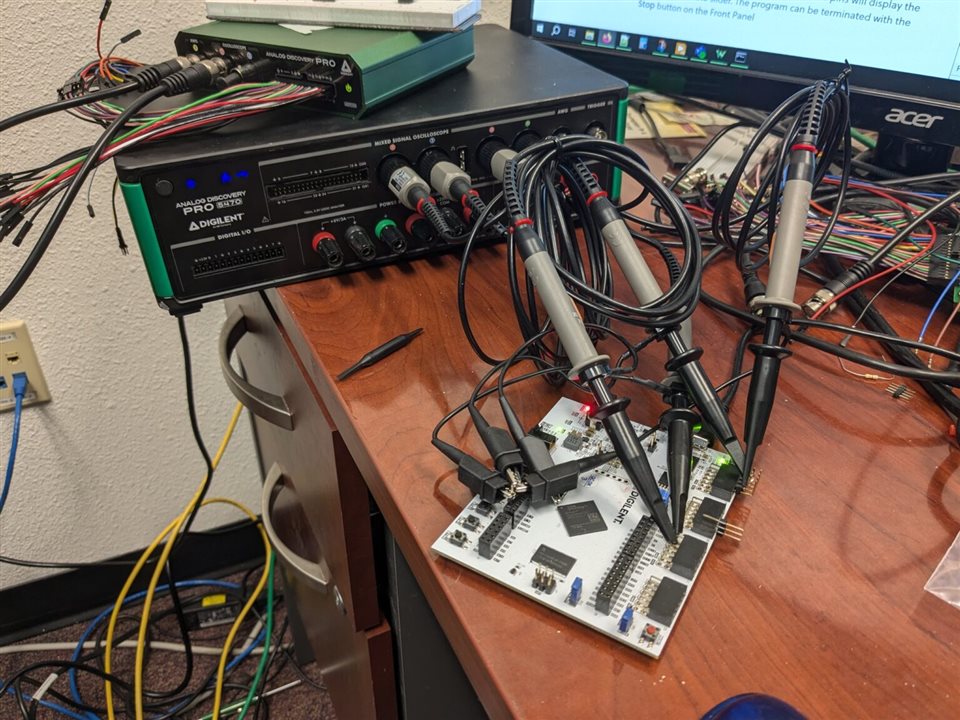
Digilent recently introduced the ADP5470 and ADP5490, two new models in the Analog Discovery Pro 5000 Series. Both are four-channel mixed-signal oscilloscopes with significantly higher bandwidth and sample rates than previous models. To test their capabilities, a project was built around measuring how fast Pmod I/O pins on an FPGA can switch — a key performance factor in many digital designs.
Why Pmod Switching Speed Matters
One of the most common questions in FPGA work is how fast a pin can toggle. This affects how quickly data can be transferred in and out of the board. Several factors impact this, including PCB trace length, quality of the connector, and whether current-limiting resistors are present. Pmod connectors are widely used due to their simplicity, but they don’t support the same speeds as more robust options like FMC or SYZYGY. Understanding their limitations helps with designing reliable systems.
Test Setup
The test was run on an Arty S7 FPGA board. The design exposed the Clocking Wizard settings through a serial interface, allowing a Python script to adjust the frequency dynamically. An ADP5490 oscilloscope was then used to capture and analyze the output waveforms on the Pmod I/O pins. The goal was to determine whether the digital signals still met the LVCMOS logic thresholds at different frequencies.
Voltage Thresholds
For 3.3V LVCMOS logic, a valid rising edge must go from below 0.4 V to above 2.4 V. These are the VOH and VOL thresholds defined in the Spartan 7 documentation. However, these thresholds are for static DC signals. When switching at high speeds, reflections, parasitic capacitance, and trace inductance can cause signal integrity issues. The oscilloscope was used to measure if these thresholds were still respected as the frequency increased.
Observations at Different Frequencies
At 10 MHz, the waveforms were clean, and the phase shifts between channels were close to the expected values — 0°, 45°, and 90° between different outputs. At 60 MHz, the signals still transitioned cleanly, but the waveform edges showed slower slew rates. Harmonics were visible, confirming the oscilloscope’s ability to capture high-frequency content.
At 75 MHz, the signals started showing unexpected behavior. The amplitude increased beyond the expected levels, possibly due to overshoot or ringing. Despite this, the transitions still crossed the logic thresholds. This result highlights how analog effects can start to interfere with digital signaling at higher speeds.
Connector-Level Differences
To understand how hardware components affect signal integrity, two different Pmod outputs were compared — one with a series resistor and one without. The scope captured clear differences in edge shape and amplitude between the two. This shows that even small changes in the signal path, like adding a resistor, can alter performance. The Scope to Digital feature in WaveForms helped confirm transitions by converting analog signals into digital logic states based on a defined threshold.
Importance of Bandwidth and Harmonics
Square waves are made up of many harmonic frequencies. To capture them accurately, a scope needs much higher bandwidth than the base frequency of the signal. For example, a 75 MHz square wave can have meaningful content up to several hundred MHz. Lower-bandwidth tools like the Analog Discovery 3 may miss these harmonics, distorting the observed signal. The ADP5000 Series scopes can capture these harmonics, giving a more accurate view of what’s actually happening at the I/O pin.
Scope Limitations and Real-World Use
All measurements were taken with only the FPGA board and the scope connected. No external modules or Pmod peripherals were attached. In a real setup, connecting other hardware would change the signal characteristics due to additional loading and parasitic effects. Results may vary depending on what’s connected to the system.
Learn More
The full article includes screenshots, waveform plots, and more details on the scope settings and observations made during testing.
To read the complete post, visit: https://digilent.com/blog/characterizing-a-pmod-ports-switching-frequency-advantages-of-a-high-bandwidth-oscilloscope/
